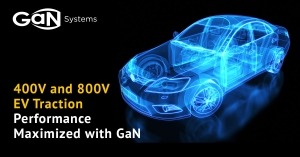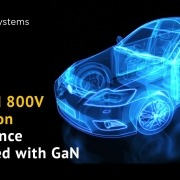GaN Advantages Growing in 400V and 800V EV Traction Design
By Paul Wiener, VP Strategic Marketing, GaN Systems
In the world of electric vehicles (EVs), performance and efficiency are paramount. As the EV industry grows, power designers constantly strive to provide more power, reduce losses, minimize heat, and shrink system sizes. These requirements stem from the ongoing pursuit of lighter vehicles with extended ranges, reduced battery size, and lower overall system costs.
The continuous drive for improvement has led to accelerated adoption of a pivotal technology transforming the landscape of EV traction design: Gallium Nitride (GaN). Particularly noteworthy are the benefits of GaN in 400V and 800V battery traction inverter designs. The growing recognition of GaN’s exceptional performance, compared to conventional silicon and SiC alternatives, underscores its critical role in the future of the EV industry.

GaN-Powered 400V Battery Traction Inverters
GaN stands out as a transformative force for 400V battery-based traction inverters—delivering the benefits that designers expect. With GaN, efficiency increases, resulting in nearly 40% reduction in power loss. Additionally, GaN power semiconductors enable a 33% increase in power density, reducing the overall size and weight of the traction inverter. Altogether, the reduced losses and smaller size result in EVs with lower costs and longer driving range, meeting critical consumer requirements.
GaN’s Emergence in 800V Battery Traction Inverters
In 800V battery-based traction inverters, the adoption of GaN-based three-level topology (3LT) is a growing trend. The demonstrated benefits are numerous.
- Higher Overall Efficiency: In addition to minimizing switching losses and increasing efficiency in the inverter, the GaN 3LT solution also reduces high-frequency copper and iron losses in the filters and motor. The inverter plus motor combined efficiency gains translates to incrementally higher efficiency compared to two-level solutions.
- Lower Noise, Harshness, and EMI Interference: The GaN 3LT generates an output voltage with a sinusoidal-like shape, resulting in reduced dV/dt and lower harmonics. The 3LT output reduces filtering requirements and minimizes high-frequency losses in filters and motors, resulting in lower noise, vibration, and harshness (NVH) characteristics. It also operates with a low common voltage, reducing insulation stress and electromagnetic interference (EMI).
- Increased Durability and Reliability: Operating at a lower common voltage also means the peak common mode voltage is suppressed, which reduces the potential for common mode voltage spikes, ensuring a smoother and more stable circuit operation. Furthermore, the 3LT decreases the strain on electric motor bearings. These operating characteristics contribute to a prolonged lifespan with increased durability and reliability.
The EV Market
EVs are at their tipping point, with more than 10 million electric cars sold worldwide in 2022, and sales are expected to grow by 35% this year to reach 14 million cars. Meeting consumer, regulatory, and OEM expectations means peak performance is critical, and this requires a holistic approach that factors in both the inverter and motor considerations. Multi-level GaN is emerging as the lynchpin, offering a range of advantages. Notably, GaN fosters high efficiency at the system level while bolstering overall system reliability.
For example, consider the all-GaN vehicle developed in collaboration with Toyota and Nagoya University teams. The All GaN Vehicle features multiple power applications of GaN in the car: in the traction inverter, the On-Board Charger (OBC), and the DC-DC converter. GaN increased power density and improved efficiency by 20% over silicon, extending the car’s driving range.
Meanwhile, Ricardo, a highly regarded global engineering firm, designed and compared a GaN inverter to a SIC-based inverter. Their test results of the 30kW inverter application demonstrated a 25% reduction in power loss and a 33% increase in power density with GaN compared to SiC. Several Tier1 and OEM automotive companies have realized similar results with traction designs up to 250kW.
In an era of EV innovation, GaN is a driving force accelerating performance and efficiency in both 400V and 800V traction inverters. With the EV industry advancing towards worldwide mass acceptance, the time for GaN adoption is now. The compelling results from rigorous testing and real-world applications point to GaN as the technology well-positioned to reshape the electric mobility landscape.


